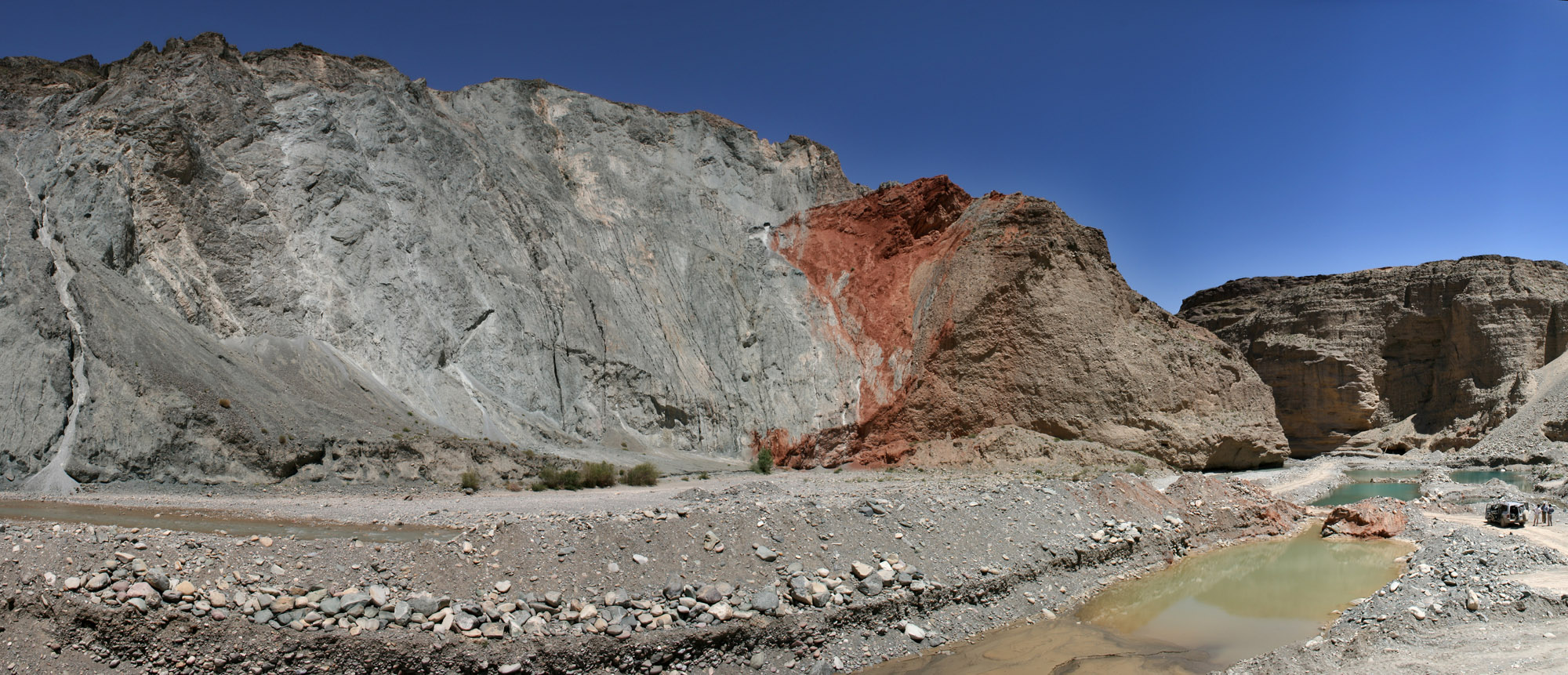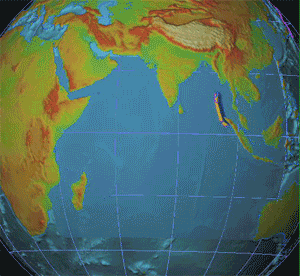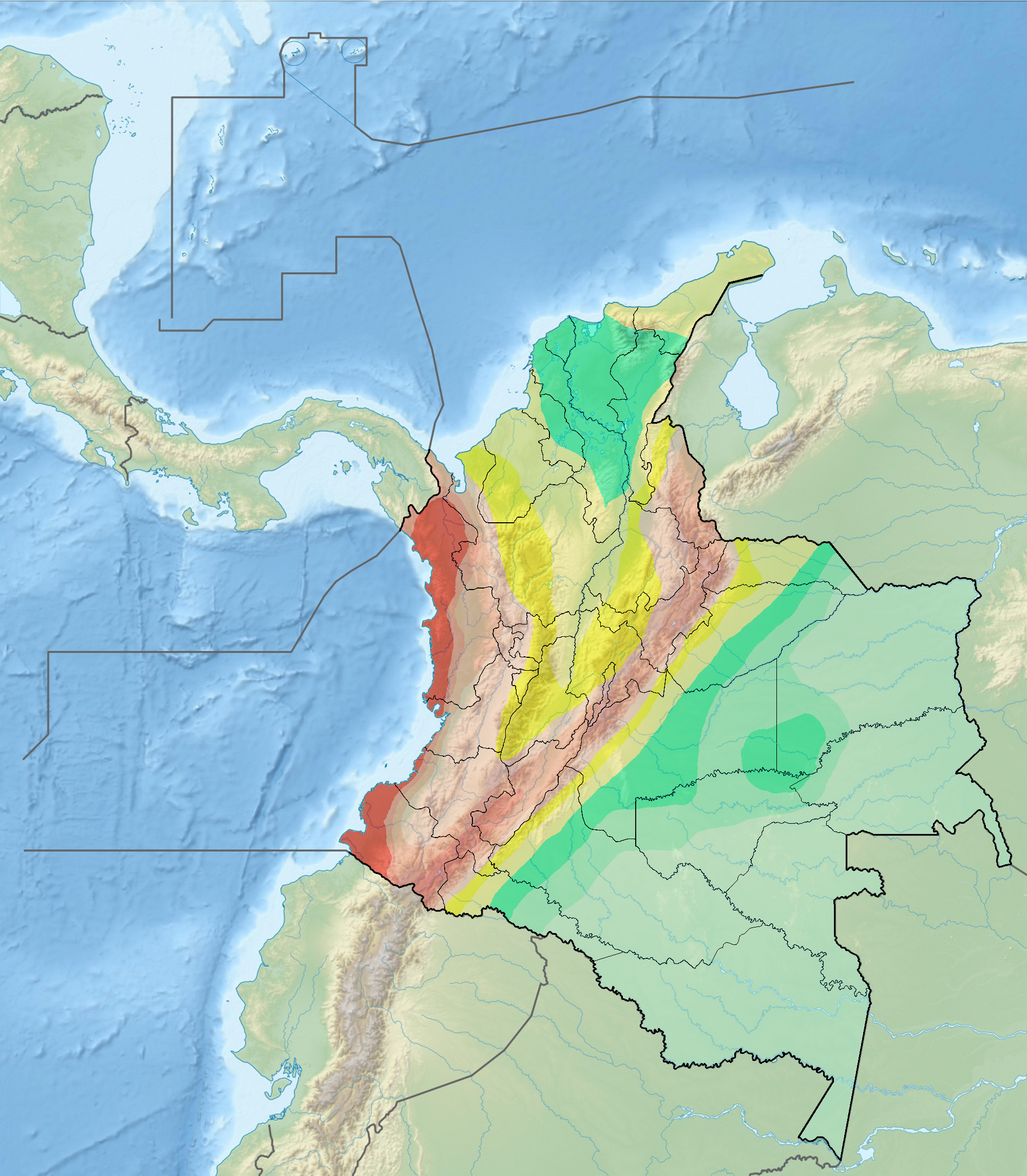|
El Bagre Fault
The Bagre Norte Fault ( es, Falla de Bagre Norte) is a sinistral thrust fault, oblique strike-slip fault in the departments of Colombia, departments of Antioquia Department, Antioquia and Bolívar Department, Bolívar in northern Colombia. The fault has a total length of and runs along an average north to south strike (geology), strike of 359 ± 14 along the Cordillera Central (Colombia), Central Ranges of the Colombian Andes and the Serranía de San Lucas. Etymology The fault is named after El Bagre.Paris et al., 2000, p.29 Description The Bagre Norte Fault branches from the Palestina Fault, close to the Alicante River. The fault juxtaposes Precambrian metamorphic rocks on the east against sedimentary rocks in the west. The fault shows as a prominent topographic lineament on satellite images and aerial photographs. Prominent scarp faces west, the fault appears to displace erosion surfaces of the Cordillera Central (Colombia), Central Ranges about . The strong geomorphologic ... [...More Info...] [...Related Items...] OR: [Wikipedia] [Google] [Baidu] |
El Bagre
El Bagre () is a town and Municipalities of Colombia, municipality in the Colombian Departments of Colombia, department of Antioquia Department, Antioquia. References Municipalities of Antioquia Department {{Antioquia-geo-stub ... [...More Info...] [...Related Items...] OR: [Wikipedia] [Google] [Baidu] |
Palestina Fault
The Palestina Fault ( es, Falla de Palestina) is a regional sinistral oblique thrust fault in the departments of Antioquia, Caldas Department, Caldas and Bolívar Department, Bolívar in central Colombia. The fault has a total length of and runs along an average north-northeast to south-southwest strike (geology), strike of 017.8 ± 11 along the Cordillera Central (Colombia), Central Ranges of the Colombian Andes. Description The Palestina Fault extends from the Serranía de San Lucas in the departments of Colombia, department of Antioquia Antioquia is the Spanish form of Antioch. Antioquia may also refer to: * Antioquia Department, Colombia * Antioquia State, Colombia (defunct) * Antioquia District, Peru * Antioquia Railway The Antioquia Railway ( es, Ferrocarril de Antioquia) i ... in the north,Buitrago et al., 2014, p. 27 to the Nevado del Ruiz volcanic zone in the south. The Otú Norte Fault, Otú Norte and Bagre Norte Faults splay off the Palestina Fault.Buitrago et al. ... [...More Info...] [...Related Items...] OR: [Wikipedia] [Google] [Baidu] |
Inactive Faults
Inactive is a TRPV TRPV is a family of transient receptor potential cation channels (TRP channels) in animals. All TRPVs are highly calcium selective. TRP channels are a large group of ion channels consisting of six protein families, located mostly on the plasma ... channel in invertebrates. Inactive mutant flies show locomotor and hearing deficits. References Ion channels Nervous system {{animal-anatomy-stub ... [...More Info...] [...Related Items...] OR: [Wikipedia] [Google] [Baidu] |
Thrust Faults
A thrust fault is a break in the Earth's crust, across which older rocks are pushed above younger rocks. Thrust geometry and nomenclature Reverse faults A thrust fault is a type of reverse fault that has a dip of 45 degrees or less. If the angle of the fault plane is lower (often less than 15 degrees from the horizontal) and the displacement of the overlying block is large (often in the kilometer range) the fault is called an ''overthrust'' or ''overthrust fault''. Erosion can remove part of the overlying block, creating a ''fenster'' (or ''window'') – when the underlying block is exposed only in a relatively small area. When erosion removes most of the overlying block, leaving island-like remnants resting on the lower block, the remnants are called ''klippen'' (singular ''klippe''). Blind thrust faults If the fault plane terminates before it reaches the Earth's surface, it is referred to as a ''blind thrust'' fault. Because of the lack of surface evidence, blind thr ... [...More Info...] [...Related Items...] OR: [Wikipedia] [Google] [Baidu] |
Strike-slip Faults
In geology, a fault is a planar fracture or discontinuity in a volume of rock across which there has been significant displacement as a result of rock-mass movements. Large faults within Earth's crust result from the action of plate tectonic forces, with the largest forming the boundaries between the plates, such as the megathrust faults of subduction zones or transform faults. Energy release associated with rapid movement on active faults is the cause of most earthquakes. Faults may also displace slowly, by aseismic creep. A ''fault plane'' is the plane that represents the fracture surface of a fault. A '' fault trace'' or ''fault line'' is a place where the fault can be seen or mapped on the surface. A fault trace is also the line commonly plotted on geologic maps to represent a fault. A ''fault zone'' is a cluster of parallel faults. However, the term is also used for the zone of crushed rock along a single fault. Prolonged motion along closely spaced faults can bl ... [...More Info...] [...Related Items...] OR: [Wikipedia] [Google] [Baidu] |
Seismic Faults Of Colombia
Seismology (; from Ancient Greek σεισμός (''seismós'') meaning " earthquake" and -λογία (''-logía'') meaning "study of") is the scientific study of earthquakes and the propagation of elastic waves through the Earth or through other planet-like bodies. It also includes studies of earthquake environmental effects such as tsunamis as well as diverse seismic sources such as volcanic, tectonic, glacial, fluvial, oceanic, atmospheric, and artificial processes such as explosions. A related field that uses geology to infer information regarding past earthquakes is paleoseismology. A recording of Earth motion as a function of time is called a seismogram. A seismologist is a scientist who does research in seismology. History Scholarly interest in earthquakes can be traced back to antiquity. Early speculations on the natural causes of earthquakes were included in the writings of Thales of Miletus (c. 585 BCE), Anaximenes of Miletus (c. 550 BCE), Aristotle (c. 340 ... [...More Info...] [...Related Items...] OR: [Wikipedia] [Google] [Baidu] |
United States Geological Survey
The United States Geological Survey (USGS), formerly simply known as the Geological Survey, is a scientific agency of the United States government. The scientists of the USGS study the landscape of the United States, its natural resources, and the natural hazards that threaten it. The organization's work spans the disciplines of biology, geography, geology, and hydrology. The USGS is a fact-finding research organization with no regulatory responsibility. The agency was founded on March 3, 1879. The USGS is a bureau of the United States Department of the Interior; it is that department's sole scientific agency. The USGS employs approximately 8,670 people and is headquartered in Reston, Virginia. The USGS also has major offices near Lakewood, Colorado, at the Denver Federal Center, and Menlo Park, California. The current motto of the USGS, in use since August 1997, is "science for a changing world". The agency's previous slogan, adopted on the occasion of its hundredth an ... [...More Info...] [...Related Items...] OR: [Wikipedia] [Google] [Baidu] |
Otú Norte Fault
The Otú Norte or Otú-Pericos Fault ( es, Falla de Otú Norte) is an inactive sinistral thrust fault, oblique strike-slip fault in the departments of Colombia, department of Antioquia Department, Antioquia in northern Colombia. The fault has a total length of and runs along an average north-northwest to south-southeast strike (geology), strike of 346.4 ± 8, cross-cutting the northern part of the Cordillera Central (Colombia), Central Ranges of the Colombian Andes. Together with the parallel Bagre Norte Fault the fault separates the Central Ranges from its northeasternmost continuation, the Serranía de San Lucas. Etymology The fault was by Feininger et al. in 1972 named after Otú Airport in vereda Otú in Remedios, Antioquia, Remedios, Antioquia Department, Antioquia.Consorcio GSG, 2015, p.168 Description The Otú Norte Fault crosses the northern part of the Cordillera Central (Colombia), Central Ranges of the Colombian Andes. The fault strikes north-northwest to south-sou ... [...More Info...] [...Related Items...] OR: [Wikipedia] [Google] [Baidu] |
Romeral Fault System
The Romeral Fault System ( es, Sistema de Fallas (de) Romeral) is a megaregional system of major parallel and anastomosing faults in the Central Ranges of the Colombian Andes and the Cauca, Amagá, and Sinú-San Jacinto Basins. The system spans across ten departments of Colombia, from northeast to south Bolívar, Sucre, Córdoba, Antioquia, Caldas, Risaralda, Quindío, Valle del Cauca, Cauca and Nariño. The fault zone extends into Ecuador where it is known as the Peltetec Fault System. The in detail described part of the Romeral Fault System south of Córdoba has a total length of with a cumulative length of and runs along an average north to south strike of 017.6 ± 16, cross-cutting the central-western portion of Colombia. The fault system, active during more than 200 million years from the Triassic to recent, represents the ancient western continental margin of northwestern South America and forms the boundary between obducted oceanic crust to the west of the f ... [...More Info...] [...Related Items...] OR: [Wikipedia] [Google] [Baidu] |
Bucaramanga-Santa Marta Fault
The Bucaramanga-Santa Marta Fault (BSMF, BSF) or Bucaramanga-Santa Marta Fault System ( es, (Sistema de) Falla(s) de Bucaramanga-Santa Marta) is a major oblique transpressional sinistral strike-slip fault (wrench fault) in the departments of Magdalena, Cesar, Norte de Santander and Santander in northern Colombia. The fault system is composed of two main outcropping segments, named Santa Marta and Bucaramanga Faults, and an intermediate Algarrobo Fault segment in the subsurface. The system has a total length of and runs along an average north-northwest to south-southeast strike of 341 ± 23 from the Caribbean coast west of Santa Marta to the northern area of the Eastern Ranges of the Colombian Andes. The fault system is a major bounding fault for various sedimentary basins and igneous and metamorphic complexes. The northern Santa Marta Fault segment separates the Sinú-San Jacinto Basin and Lower Magdalena Valley in the west from the Sierra Nevada de Santa Marta to the east. ... [...More Info...] [...Related Items...] OR: [Wikipedia] [Google] [Baidu] |
List Of Earthquakes In Colombia
This is a list of earthquakes in Colombia. Colombia is a seismically active country and has a large seismic risk in many areas of its territory due to its location at the boundaries of the Malpelo, Panama, Caribbean, North Andes (where most earthquakes occurred) and South American Plates along the Pacific Ring of Fire. The southeastern and extreme eastern portions of Colombia are not as seismically active as the rest of the country. The first historically registered earthquake felt in Colombia occurred on September 11, 1530, around 10:00 AM, probably with the epicentre near Cumaná, Venezuela. The earthquake was documented by Gonzalo Fernández de Oviedo y Valdés in his work ''La Historia general de las Indias'' and by friar Bartolomé de las Casas in his book ''Historia de Las Indias''.Ramírez, 1975, p.63 The first documented earthquake with its epicentre in present-day Colombia territory took place in 1566,Ramírez, 1975, p.65 with the epicentre estimated around San ... [...More Info...] [...Related Items...] OR: [Wikipedia] [Google] [Baidu] |
Sedimentary Rock
Sedimentary rocks are types of rock that are formed by the accumulation or deposition of mineral or organic particles at Earth's surface, followed by cementation. Sedimentation is the collective name for processes that cause these particles to settle in place. The particles that form a sedimentary rock are called sediment, and may be composed of geological detritus (minerals) or biological detritus (organic matter). The geological detritus originated from weathering and erosion of existing rocks, or from the solidification of molten lava blobs erupted by volcanoes. The geological detritus is transported to the place of deposition by water, wind, ice or mass movement, which are called agents of denudation. Biological detritus was formed by bodies and parts (mainly shells) of dead aquatic organisms, as well as their fecal mass, suspended in water and slowly piling up on the floor of water bodies ( marine snow). Sedimentation may also occur as dissolved minerals precipita ... [...More Info...] [...Related Items...] OR: [Wikipedia] [Google] [Baidu] |






